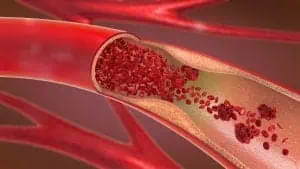
Deep vein thrombosis (DVT) occurs when a blood clot forms in one or more of the deep veins in the body, typically the legs. DVT can cause leg pain and/or swelling, but can also occur with no symptoms. DVT is most prevalent in people with certain medical conditions that affect how their blood clots; however, DVT can also occur due to prolonged inactivity – such as when a person is confined to a bed following surgery.
According to the American Heart Association, up to 2 million Americans are affected each year by DVT. Deep Vein Thrombosis can be serious because it can cause a pulmonary embolism. This happens when blood clots in veins break loose, travel through the bloodstream, get lodged in the lungs and block blood flow. This can be life-threatening, and is why, at Water’s Edge Dermatology, we are committed to raising awareness of diseases like DVT – so people can receive treatment for DVT before a more serious medical issue occurs.
Read on to learn more about Deep Vein Thrombosis.
Symptoms
- Swelling in the affected leg
- Pain in the leg
- Red or discolored skin on the leg
- A feeling of warmth in the affected leg
If you experience any of these symptoms, contact your doctor immediately.
Risk Factors
- Long distance flights
- Inheriting a blood-clotting disorder
- Prolonged bed rest
- Injury
- Surgery
- Pregnancy
- Taking birth control pills or hormone replacement therapy
- Being overweight or obese
- Smoking
- Cancer
- Heart failure
- Inflammatory bowel disease
- Personal or family history of DVT or PE
- 60 years of age or older
- Sitting for long periods of time
The more risk factors you have, the greater your chance of developing DVT.
Prevention
Even if you have some of the risk factors, there are steps you can take to help prevent DVT:
- Avoid sitting for prolonged periods of time. If you had surgery and/or are on bed rest, get moving as soon as you can.
- If traveling by car, stop every hour or so to walk around. If traveling by plane, exercise your lower legs by raising and lowering your heels with your toes on the floor, then raise your toes with your heels on the floor.
- Make lifestyle changes (lose weight, quit smoking, etc.).
- Exercise regularly. This is especially important for people who sit or travel a great deal.
Treatment
If you are diagnosed with DVT, there is plenty of good news. Today’s advanced technology allows doctors to remove blood clots right after they occur and restore normal blood flow in the leg to relieve symptoms. This can be performed in an outpatient procedure.
If you or a loved one are experiencing symptoms related to DVT, contact The Vein Center at Water’s Edge today to schedule an appointment. Our Vein team will conduct a thorough evaluation and discuss any recommended treatment options with you so you can get relief quickly. Request an Appointment Online or Call (877) 533.8214.





